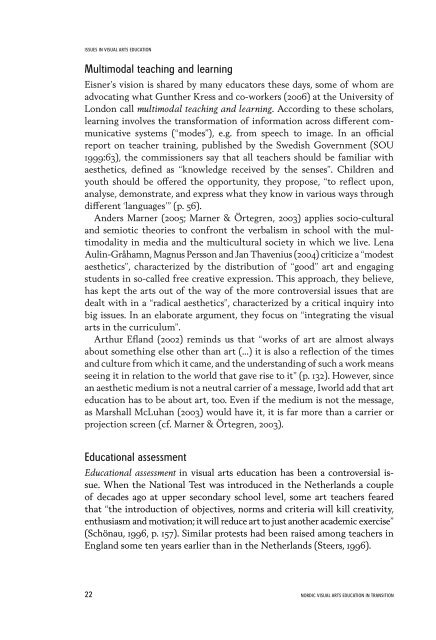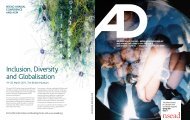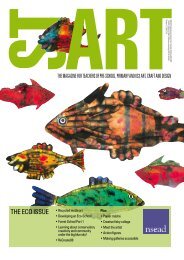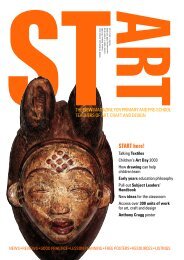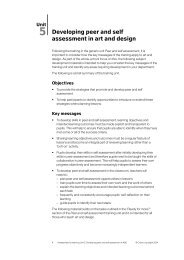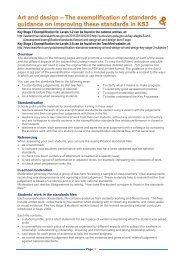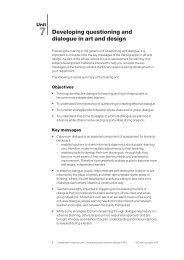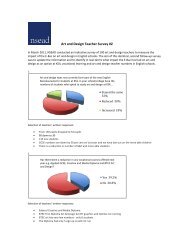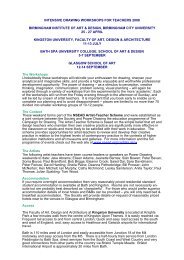Research in Visual Arts Education - Bilderlernen.at
Research in Visual Arts Education - Bilderlernen.at
Research in Visual Arts Education - Bilderlernen.at
You also want an ePaper? Increase the reach of your titles
YUMPU automatically turns print PDFs into web optimized ePapers that Google loves.
ISSUES IN VISUAL ARTS EDUCATIONMultimodal teach<strong>in</strong>g and learn<strong>in</strong>gEisner’s vision is shared by many educ<strong>at</strong>ors these days, some of whom areadvoc<strong>at</strong><strong>in</strong>g wh<strong>at</strong> Gunther Kress and co-workers (2006) <strong>at</strong> the University ofLondon call multimodal teach<strong>in</strong>g and learn<strong>in</strong>g. Accord<strong>in</strong>g to these scholars,learn<strong>in</strong>g <strong>in</strong>volves the transform<strong>at</strong>ion of <strong>in</strong>form<strong>at</strong>ion across different communic<strong>at</strong>ivesystems (“modes”), e.g. from speech to image. In an officialreport on teacher tra<strong>in</strong><strong>in</strong>g, published by the Swedish Government (SOU1999:63), the commissioners say th<strong>at</strong> all teachers should be familiar withaesthetics, def<strong>in</strong>ed as “knowledge received by the senses”. Children andyouth should be offered the opportunity, they propose, “to reflect upon,analyse, demonstr<strong>at</strong>e, and express wh<strong>at</strong> they know <strong>in</strong> various ways throughdifferent ‘languages’” (p. 56).Anders Marner (2005; Marner & Örtegren, 2003) applies socio-culturaland semiotic theories to confront the verbalism <strong>in</strong> school with the multimodality<strong>in</strong> media and the multicultural society <strong>in</strong> which we live. LenaAul<strong>in</strong>-Gråhamn, Magnus Persson and Jan Thavenius (2004) criticize a “modestaesthetics”, characterized by the distribution of “good” art and engag<strong>in</strong>gstudents <strong>in</strong> so-called free cre<strong>at</strong>ive expression. This approach, they believe,has kept the arts out of the way of the more controversial issues th<strong>at</strong> aredealt with <strong>in</strong> a “radical aesthetics”, characterized by a critical <strong>in</strong>quiry <strong>in</strong>tobig issues. In an elabor<strong>at</strong>e argument, they focus on “<strong>in</strong>tegr<strong>at</strong><strong>in</strong>g the visualarts <strong>in</strong> the curriculum”.Arthur Efland (2002) rem<strong>in</strong>ds us th<strong>at</strong> “works of art are almost alwaysabout someth<strong>in</strong>g else other than art (…) it is also a reflection of the timesand culture from which it came, and the understand<strong>in</strong>g of such a work meanssee<strong>in</strong>g it <strong>in</strong> rel<strong>at</strong>ion to the world th<strong>at</strong> gave rise to it” (p. 132). However, s<strong>in</strong>cean aesthetic medium is not a neutral carrier of a message, Iworld add th<strong>at</strong> arteduc<strong>at</strong>ion has to be about art, too. Even if the medium is not the message,as Marshall McLuhan (2003) would have it, it is far more than a carrier orprojection screen (cf. Marner & Örtegren, 2003).<strong>Educ<strong>at</strong>ion</strong>al assessment<strong>Educ<strong>at</strong>ion</strong>al assessment <strong>in</strong> visual arts educ<strong>at</strong>ion has been a controversial issue.When the N<strong>at</strong>ional Test was <strong>in</strong>troduced <strong>in</strong> the Netherlands a coupleof decades ago <strong>at</strong> upper secondary school level, some art teachers fearedth<strong>at</strong> “the <strong>in</strong>troduction of objectives, norms and criteria will kill cre<strong>at</strong>ivity,enthusiasm and motiv<strong>at</strong>ion; it will reduce art to just another academic exercise”(Schönau, 1996, p. 157). Similar protests had been raised among teachers <strong>in</strong>England some ten years earlier than <strong>in</strong> the Netherlands (Steers, 1996).22 NORDIC VISUAL ARTS EDUCATION IN TRANSITION


